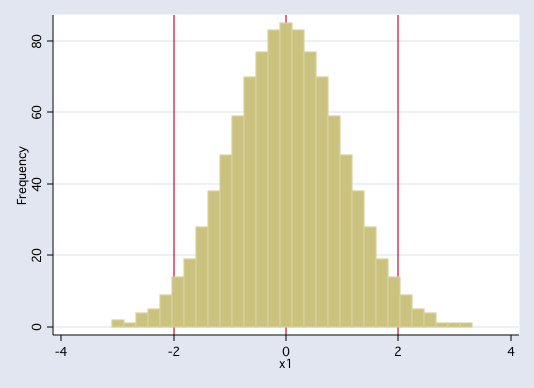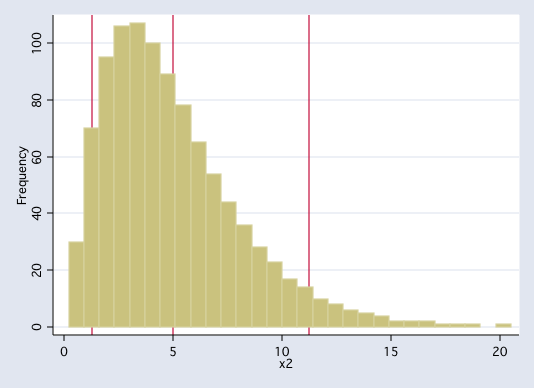
By now you are quite comfortable with the fact that for a normal distribution .6826 of the cases fall between +1 and -1 standard deviations. Or that .9544 of the cases fall between +2 and -2 standard deviations. The histogram below shows a normal distribution with vertical lines at the mean of zero, -2 standard deviations and +2 standard deviations.

The actual empirical proportion for this example is .955, which is pretty darn close.
But what if the distribution is not normal? What can we say about the proportion of cases that fall between given standard deviations? The probabilities found the the tables of the standard normal distribution are no longer applicable.
What we can do is use Chebyshev's Theorem (Pafnuty Chebyshev, 1821-1894; sometimes spelled Tchebycheff), which states that for any population or sample, the proportion of observations, whose z score has an absolute value less than or equal to k, is no less than (1 - (1 / k2 )).
Consider, the example in the hisogram below with vertical lines at the mean, -2 and +2 standard deviations.

It is obviously non-normal with a mean of 4.99 and standard deviation of 3.13. Chebyshev's Theorem for two standard deviations (k = 2) is calculated like this:
This is interpreted to mean that at least .75 of the observations will fall between -2 and +2 standard deviations. In fact, for the example distribution .891 of the observations fall with that range. It is the case the 7.5 is less than or eaual to .891.
Now, you might think that 75% is not very close to 89.1% but you have to realize that Chebyshev's Theorem holds for any population or sample no matter its shape.
There is a down side to using Chebysev and that is it doesn't give any results for standard deviations less than or equal to one. Here is a small table of some of the Chebyshev results for k greater than 1.
k p 1.25 .36 1.50 .56 1.75 .67 2.00 .75 2.25 .80 2.50 .84 2.75 .87 3.00 .89 3.25 .91 3.50 .92 3.75 .93 4.00 .94
Intro Home Page
Phil Ender, 24Oct04